"Concerto" talk with Paul Mann
On October 1st, 2012 “The Highway Star” had the opportunity to do an interview with Paul Mann. Being the conductor of the 1999 “Concerto For Group And Orchestra” performance and the subsequent Deep Purple world tour, Paul became a close friend to Jon Lord. Being also heavily involved in the making of the brand new studio recording, he shares some insight on various topics.
… choosing the musicians
Right from the start my feeling was – and it was one Jon shared – that we should try to make this new recording about the piece itself, as a composition of Jon’s - to try and cast the net wider than Deep Purple. Which is not to take anything away from them - they made it so much their own through the original performance and the thirty or so performances we did between 1999 and 2001. But for some people it became regarded as Deep Purple’s rather than Jon’s Concerto for Group and Orchestra.
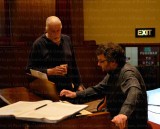 I wanted to try to make a recording that came as close to what I understood as his intention and certainly my own feelings about the piece, and to bring it as close to the ideal as we possibly could. The idea was to try to choose people that would be suited to each particular part rather than to use a single band. We would sort of handpick the guitarists, and what we ended up with was a very interesting cross-section of people:
I wanted to try to make a recording that came as close to what I understood as his intention and certainly my own feelings about the piece, and to bring it as close to the ideal as we possibly could. The idea was to try to choose people that would be suited to each particular part rather than to use a single band. We would sort of handpick the guitarists, and what we ended up with was a very interesting cross-section of people:
Darin Vasilev, this Bulgarian guitarist who Jon had played live with a few times and had really loved his playing. I didn’t conduct any of those performances, but he told me about this amazing guy and said “I think we really should have him on the recording.“ He’s been the real discovery of this project for me - really outstanding. Joe [Bonamassa] of course is such a great blues guitarist that he’s perfect for the second movement.
When it came to the third movement, all sorts of names were being mentioned and finally I said to Jon: “Look, everyone that we’re thinking of, I would end up saying to them: go and listen to what Steve Morse did back in 1999 and do something like that!” And if you’ve got a great star name, you can’t start telling them to play like someone else, so in the end I just said to Jon “Why don’t we just ask Steve to do it?” So I called him, and he was in the middle of writing sessions for the new album in Germany and as usual was massively busy, but he dropped everything and said “Yes of course, anything for Jon. I’ll do it tonight." A couple of days later I got some e-mails with three completely different takes of the whole movement. It was incredibly difficult to choose one. I wanted to release them all as extras so everyone could hear how great they were. Maybe we will one day. Thirtieth anniversary remaster…
But in the end it was good to have Steve alongside Jon to represent the quintessential spirit of Deep Purple and also still have a way to acknowledge everything the band did for the piece. It’s a good way of having the best of both worlds in that sense.
… recording with Bruce Dickinson
I was really impressed with Bruce both as a singer and as a person. I spent the day with him at Abbey Road and although Jon was there, he wasn’t well that day and he went off to rest at a certain point and left me to work with Bruce. Later in the day Jon re-emerged and we played him what we’d done.
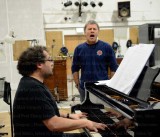 We started out with me playing it on the piano while Bruce learned it and I straight away noticed how analytically and thoughtfully he was working. Every take he did, he listened to it and registered something and then went back down and tried something different or said: “What is it about that? Why isn’t that working? Can you tell me something about that?” So there was a constant analysing going on and one of the things he said on that day was how much he was enjoying doing something so “musically pure”, just about making the best music rather than there being any other agenda to it.
We started out with me playing it on the piano while Bruce learned it and I straight away noticed how analytically and thoughtfully he was working. Every take he did, he listened to it and registered something and then went back down and tried something different or said: “What is it about that? Why isn’t that working? Can you tell me something about that?” So there was a constant analysing going on and one of the things he said on that day was how much he was enjoying doing something so “musically pure”, just about making the best music rather than there being any other agenda to it.
When you hear him on the recording, that very last thing when he goes to the top of the register, on the very last phrase, he searched and searched and searched to find exactly the right shape for it. Somehow I wish I kept all takes so we could hear how he arrived at it. He did it so thoughtfully and with such artistry, he’s just a fascinating guy and was a perfect choice for this.
Side by side with Bruce we got Steve Balsamo and Kasia Laska who are very different in vocal style, much more gentle. Jon worked with both of them a lot and loved the beautiful sound they make together. So again it was another way to try to renew the feel of the piece instead of it being one vocalist doing everything. It now has a different shape with this kind of intimate duet and then the more muscular style of Bruce. I think it reflects the meaning of the lyrics in a different way.
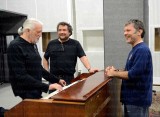 Everyone knows the story that Ian wrote the lyrics on the day of the performance at the last possible moment. It just reflects his anxiety about the whole thing. “My god! What shall I do when I stand there and don’t know what to do and when to start and when to stop and I’m lost? What shall I do when they start laughing at me? What shall I do when it all goes wrong?” Those sentiments were very real for him, and what Bruce brings to it is his own interpretation of that sense of anxiety. He manages to make it very personal. He has that way of all the best singers, something that Ian also has, that Ronnie had, of not just singing words but living the meaning of them.
Everyone knows the story that Ian wrote the lyrics on the day of the performance at the last possible moment. It just reflects his anxiety about the whole thing. “My god! What shall I do when I stand there and don’t know what to do and when to start and when to stop and I’m lost? What shall I do when they start laughing at me? What shall I do when it all goes wrong?” Those sentiments were very real for him, and what Bruce brings to it is his own interpretation of that sense of anxiety. He manages to make it very personal. He has that way of all the best singers, something that Ian also has, that Ronnie had, of not just singing words but living the meaning of them.
He came in with a totally open mind. I think he’d listened to our live recording, or maybe the old one, but we starting by writing out the words and it was just a completely clean slate. Over the course of the afternoon he went from that to an absolutely finished interpretation and making it his own. It was one of the most wonderful days of my musical life working with him. I found him totally inspiring.
The great thing about music is you never stop learning, and I’m always looking for what I can learn from people. Certainly here was someone I could learn from and I was thinking the whole day, the energy, the commitment, the fearless and yet controlled way he throws himself at things is something a lot of other classical musicians could learn from.
… Joe Satriani, Steve Lukather and Lars Ulrich being thanked in the booklet
I don’t know for sure because there were so many names were mentioned, different people approached at different stages. Some were very enthusiastic but weren’t available, some didn’t want to do it, maybe some felt a bit intimidated by the whole orchestra thing and didn’t want to do that, and there were also some who really wanted to be involved but their own commitments made it impossible – so I guess those names fall somewhere in those categories!
… how Jons illness affected the recording sessions
Most of Jon’s part was recorded in Liverpool at the beginning of June 2011, before the cancer was diagnosed. The only part of his performance that was recorded after his illness had begun was his solo for the second movement, which was recorded on the same day in August 2011 that Bruce did his vocals. At that time Jon was already beginning to show some alarming signs.
On that day we were not sure whether he would be well enough or whether he would feel like putting the solo on, but he did as you will see in the documentary film that is coming with this recording later in the year. It was a very emotional day - what he did was so beautiful given the circumstances he was in. He just went in and did one take, and it’s about a minute of distilled Jon Lord. It was the most memorable day of the whole thing, and it’s interesting because you can listen to it side by side with the Jon we all know and love, the raging, roaring, exciting side of Jon, that Hammond-burning Jon sound in the first and last movements. There’s one moment towards the end of the third movement, something he started to introduce into his performances, those lion roars that he made the Hammond do and I made sure that they were turned up nice and loud in the mix. But as a contrast to that you have this very intimate, very personal solo which seems to encapsulate everything about the state he was in. That combination of contradictory feelings - him feeling ill and weak, determined and strong, and also frustrated and enraged and serene and calm and somehow at peace with things, all at the same time. At that stage, Jon’s musical personality was so assured that he could focus his mind and channel it all into his music-making, producing something very pure and very direct.
When you face a tremendous fear, not that I have any experience of fear on that scale, I’m sure begins to show in your music making. Every note, every moment, every gesture counts and you hear that in his solo. It’s extraordinarily beautiful playing, even by his standards.
… recording in the studio compared to live recordings
A recording studio can sometimes be a quite sterile environment because you don’t have an audience to play for and in this situation we also didn’t even have the whole band there.
One of the things I’m used to with this piece is vibing off the band the whole time. They generate an energy which we pick up on, and the orchestra generates its energy and the band picks up on that and it’s goes backwards and forwards. We didn’t have that here, because only Jon, Guy [Pratt] and Brett [Morgan] – the rhythm section basically - were actually at the orchestra sessions, and Jon’s Leslie was out in a back corridor somewhere, while the drummer was hidden away in a dressing room. All done for separation, but basically I couldn’t hear them. So I guess I was worried it might be a sterile way to do it, but somehow I just took all the risks that I always wanted to take with it.
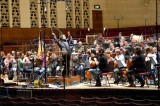 With the Concerto it wasn’t always possible in a live performance to do everything you might set out to do. All the stories, which we know very well, about the trouble we sometimes had playing the concerto for rock audiences who were not necessarily ready to sit through a lot of very slow, quiet music. The second movement became a bit hurried in some of those performances because I was worried about losing the audience’s concentration.
With the Concerto it wasn’t always possible in a live performance to do everything you might set out to do. All the stories, which we know very well, about the trouble we sometimes had playing the concerto for rock audiences who were not necessarily ready to sit through a lot of very slow, quiet music. The second movement became a bit hurried in some of those performances because I was worried about losing the audience’s concentration.
The last movement is also quite difficult to hold together because it’s extremely fast and rhythmically very precise and when you push it too far it can start to fray at the edges. So in some of the later live performances maybe it got a little bit too safe. In the studio recording - especially with a great orchestra like the Royal Liverpool Philharmonic, which is up for anything and a total virtuoso orchestra – I could push for all the things I always wanted to achieve with the piece. And of course, if it falls flat on its face, you can always stop and do a retake, which you can’t in concerts.
So there is a kind of paradox, a kind of contradiction: a sterile studio environment can also liberate you to take a few more risks. I was well aware that this was our one chance to get the performance that we’d been dreaming of.
I’m very proud of the 1999 recording. I think it has a special energy and some very beautiful playing from the orchestra and I have no complaints about it, except that there are a small number of accidents which annoy me every time I hear them - little things that are not together, a couple of false entries. Things like that start to bother you when you hear them repeatedly. There’s also the fact that in live performances of this piece, balancing the band and orchestra was always going to be a compromise, even with current technology. Back in 1969, it must have been just impossible to do that. I remember Jon always said that the band was just turned way down because it was the only way you could hear the orchestra. That’s why on the old recording the band makes that really brittle sound, because of the reduced level they had to play at. In 1999, and on the tour, it was much more sophisticated than that, and Moray and Rob did an amazing job in making everything work, but still there are a lot of details that were lost in the overall sound picture.
In the studio we could get really inside it and find all those details and try to make the piece sound natural, as Jon heard it in his imagination when he was lying on his floor in Parsons Green in 1969 writing the piece. I think he imagined a sound that wasn’t possible to make a reality at the time, but which we can do now with studio technology, particularly with a great engineer like Andrew Dudman who’s one of the star engineers at Abbey Road. Not just a technician, but an artist with it. With all that you can make it much clearer than we ever could live and I know that this was something Jon was delighted by.
… leaving out the second movement during some live shows
We did that a few times and it was always a decision we had to take beforehand because of course you have to tell the orchestra. So we usually had to make a kind of guess about what kind of audience it was going to be like. In retrospect I regret some of the nights we didn’t play it because I think we occasionally underestimated the audience and I wish we hadn’t done that. There were also one or two places where we overestimated the audience [laughs].
Certainly that whole last section from where the vocals end, from Jon’s solo right to the end of the movement, is for me the heart of the piece. That’s where its soul lies. The transition from the organ solo, to the string quartet and that very intimate, very desolate music where Jon always said “What was I thinking? Where did that come from?” That extreme, almost Shostakovich-like desolation at the end of the second movement. He never quite knew where it came from, it was a surprise even to him. It was sometimes difficult in a live performance to give it all the time that I felt it needed.
Obviously in the studio, where you can completely control every aspect of the situation I could take every risk and played it very slowly. I hope not exaggeratedly so, just to give it all the time I felt it needed. We made a very small change on the last chord - one of the many hundreds of little detail changes we made to the orchestration. At the very end of the movement the woodwinds and the strings play the last chord, but we asked the woodwinds to stop their chord and allow the strings just to keep playing until they run out of bow. So the chord doesn’t end, it just fades away. Also, when listening for the first time to the whole recording all the way through I realized that the transition from the end of the second movement to the third movement now is really different because you don’t get the audience applause.
Instead of the ovation on the live recording, now we have silence as the second movement dies away, then the last movement bursts in with that very brassy exciting opening, shattering the atmosphere. And it takes on a whole new meaning. It’s more organic as a whole - rather than three separate parts.
… Marco de Goeij
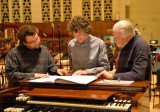 It took Marco [de Goeij] nearly two years to reconstruct the “Concerto”. He started in 1997 and I think it was around late winter/spring 1999 that he finally approached Jon. It was a huge amount of work, just sit down and begin - where do you start with something like that? It’s amazing.
It took Marco [de Goeij] nearly two years to reconstruct the “Concerto”. He started in 1997 and I think it was around late winter/spring 1999 that he finally approached Jon. It was a huge amount of work, just sit down and begin - where do you start with something like that? It’s amazing.
Jon tried a couple of times to do it himself. He was getting so many requests from people to play the Concerto but in the end I think he just gave up because it was too time-consuming to contemplate that amount of work, especially as he was all the time on the road with Deep Purple.
Marco’s actual involvement in terms of working on the “Concerto” ended back in 1999 when we did those original performances. But he’s been very much part of the story all the way through and I never lose an opportunity to tell everyone that we’re only able to play this piece because of him. Without him the piece would have been lost forever.Jon would never have found the time to sit down and reconstruct it himself.
Marco was there at the sessions. We just felt it was important to have him there.
… future releases of other works
In 2010 Jon made a new score of “Sarabande” for group and orchestra and premiered it in Hungary. So we have the score of that and I would love to find a way to record it in the studio. With the right cast, it would be great. Of course, we now have the huge problem of who we’d get to play the keyboards. But I’d still love to do it. But I guess we’ve probably spent so much money on this new concerto recording that it’ll be a while before that becomes a realistic possibility.
One of the other things that I’m waiting to see is what sort of state the score of “Gemini Suite” is in. I think there’s a lot of good music in that which could be revisited.
Jon left a lot of music behind and one of the things that I’m doing now – and it’s a very long-term project - is to look at the completed scores, all the finished pieces that he left, and it’s complicated by the fact that Jon was such an inveterate reviser. Every time he played a piece he would make little alterations of various kinds, and these didn’t always find their way into the scores, so it’s a long process to get everything into shape for the first time.
I’m also working very closely with Jon’s family, and with his manager Tarquin Gotch to look through all the music he left behind that was not complete. There are a number of pieces he was writing at the time of this death that he didn’t finish, of which he left substantial bits and we need to see if there are things we might salvage, while of course being very careful about not bringing stuff before the public which he wouldn’t have wanted us to.
He was also writing songs with Steve Balsamo, and some orchestra works that he didn’t finish. There are also some pieces from the first half of the decade after he left Deep Purple that were also unfinished. I need to spend some more time going through that material to see what there is.
Still remaining unrecorded is also his last big piece, which was the symphonic version of “From Darkness To Light”. Back in 2000 he wrote this choral piece for his local church and in the last year of his life he expanded it into a big work for full orchestra and chorus and soloists. That was premiered in Germany by the Hagen Philharmonic and Florian Ludwig earlier this year. Jon was very very happy with that performance, but as usual he wanted to make changes, and the only record I have of these is some scribbles on my score, made during a phone conversation after the German broadcast.
Anyway, we want to record that, but it’s a question of raising the money to do it. It’s an expensive business. But it would be a nice epitaph to stand alongside the Concerto. Put it this way: I am certain we haven’t heard the last of him yet!
… comparing the “Concertos” - 1969, 1999 and 2012
It’s such a long journey between all those different versions.
Between the 1969 and the 1999 one, there were a lot of changes. Jon made a couple of cuts, tightened the structure in a few places, and made a few quite substantial alterations to some sections, including adding an extra verse in the second movement. In the 1999 version he also goes twice round the Hammond tune near the beginning of the third movement, where in the 1969 it’s only once. There are various things like that.
The new one has no changes to the substance of the music, except for one small place in the first movement in the final build-up, where a couple of bars were added because Jon felt the balance of the phrase was not quite right. That was the only place where he went back to the 1969 version because he liked better what he’d originally written. A lot of the changes in the new version are what you might call ‘cosmetic’, to do with the orchestration, to do with the balance, and colours of the orchestra.
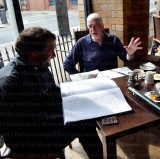 Jon learned a lot more about orchestration in the last ten years and I think he applied a lot of that to the new version. Also, a few weeks before the sessions in Liverpool, I listened to the 1969 recording which I hadn’t heard for a long time – I’d deliberately stayed away from it. But I suddenly started hearing things I’d never heard before. It’s partly I think because that remastered version is much clearer than the old one, but also maybe because I’m hearing it with different ears after all this time. I made a list of maybe ten or so places where I heard something different and I took it to Jon and we listened to it together and agreed: “Yes, that’s a different note there. That’s a different chord. And yeah, the horns are not playing there.” That sort of thing and he decided that he was going restore the ’69 version in those places.
Jon learned a lot more about orchestration in the last ten years and I think he applied a lot of that to the new version. Also, a few weeks before the sessions in Liverpool, I listened to the 1969 recording which I hadn’t heard for a long time – I’d deliberately stayed away from it. But I suddenly started hearing things I’d never heard before. It’s partly I think because that remastered version is much clearer than the old one, but also maybe because I’m hearing it with different ears after all this time. I made a list of maybe ten or so places where I heard something different and I took it to Jon and we listened to it together and agreed: “Yes, that’s a different note there. That’s a different chord. And yeah, the horns are not playing there.” That sort of thing and he decided that he was going restore the ’69 version in those places.
So some of the changes that you hear on the new recording are actually an attempt to get closer to the 1969 version, in a few places where we’d missed it in ’99, or where we’d deliberately tried something different. Hindsight is a wonderful thing!
And I suppose - without wishing to blow my own trumpet in any way - I’ve done this piece a lot now and I’d started to develop a much clearer sense of the way I think it should go and the things I wanted to do with it. I felt I could use that experience and be aware of the dangers and make sure that it sounds at its best. When you do so many performances of a work, you have the luxury of learning and hopefully applying the lessons. I hope the combination of all those things makes it sound fresh.
… Jon Lord between two worlds
One thing that I’ve already found interesting about the way the new recording is being received is that a lot of classical people, who previously might have been perhaps a bit sniffy about Jon for reasons of their own, suddenly are taking it a lot more seriously. I think it’s partly the result of the things he did during the last ten years, the pieces he wrote, the circles he moved in, the orchestras that played his music.
It’s also nice to see some of those people who might previously have thought that he was just another of those dabbling rock musicians realizing how wrong they were, that he was a really serious artist who knew exactly what he was doing.
He understood orchestras. All the stuff that I did with Jon, every time, every orchestra - it didn’t matter who they were - even if they started with that bit of sceptical “Who does he think he is?” - within the first ten minutes of every rehearsal, they suddenly realized “My god, this is actually serious stuff!” They picked up how well he understood them, their world, their way of thinking, and that’s one of the reasons they liked working with him so much.
It’s so rare to find someone who was as comfortable as he was in both worlds. He was able to live in them equally happily, and with equal ease, and that’s an amazing gift, and also the product of a lot of very very hard work. Perhaps now that he’s gone, some of those people who didn’t realize maybe will now get it, and I hope the new recording might go towards that in some way.
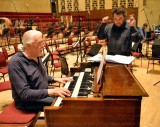 I think he couldn’t have done what he did in the last ten years of his life if he had remained in Deep Purple, and I know how hard that was for him. I know because I was there, all that whole period which he began seriously to think about it from the Concerto tour onwards. That famous night in Ipswich, after his last show with the band, we stayed up all night and we talked, and talked and talked about the ambivalence of his feelings, the conflicts within him. And yet he knew what he had to do. He knew that if he stayed in Deep Purple he wouldn’t be able to find out if he could be a composer, and he needed to do that. Listen to that little piece on “Beyond the Notes”, “De Profundis”. At the beginning and the end, it’s a really ingenious and very sad collage of quotes from Deep Purple songs. At one point, the oboe plays the opening theme of the concerto, and the cellos play very softly and slowly, his solo from “Highway Star”. That’s it in a nutshell.
I think he couldn’t have done what he did in the last ten years of his life if he had remained in Deep Purple, and I know how hard that was for him. I know because I was there, all that whole period which he began seriously to think about it from the Concerto tour onwards. That famous night in Ipswich, after his last show with the band, we stayed up all night and we talked, and talked and talked about the ambivalence of his feelings, the conflicts within him. And yet he knew what he had to do. He knew that if he stayed in Deep Purple he wouldn’t be able to find out if he could be a composer, and he needed to do that. Listen to that little piece on “Beyond the Notes”, “De Profundis”. At the beginning and the end, it’s a really ingenious and very sad collage of quotes from Deep Purple songs. At one point, the oboe plays the opening theme of the concerto, and the cellos play very softly and slowly, his solo from “Highway Star”. That’s it in a nutshell.
The courage of what he did is quite astounding when I think of it. At the age of around 60, at the very top of your game, you totally change your life. With that amount of success and that amount of fame and - let’s be frank about it - that amount of money from being a member of one of the greatest bands in the world suddenly to say “I have to find out if I can be a composer and the only way to do it is to turn my back on it all.” I think it was an act of astonishing bravery and vision, and I know how much it cost him, and I’m speaking emotionally, spiritually here.
Everything from “Boom Of The Tingeling Strings” right up to the most recent pieces that he was working on when he left us, none of that would have been possible as a member of Deep Purple because he would never have had the time. To compose music, you need solitude. You can’t go from hotel to hotel to dressing room to gig, back to hotel, getting on the plane, that’s impossible.
The last years of his life were a vindication of that act of courage and I know there were times when it was very very difficult and he really missed the band. But I hope that posterity will give him his due, and show that there is a lot of music that would never had existed if he hadn’t made that move.
That shows tremendous determination and strength of character at an age when you might expect someone just to start taking it easy. He challenged himself and did it on the biggest possible scale with some of the world’s major orchestras, doing it properly with some very, very serious people, holding his head up high with all of them.
There’s no one else who has done anything close. All the people that are routinely compared with Jon are not in the same category at all. He’s in a category of his own.
… personal future plans
I’m just doing my usual thing: concerts all over the place and I have my new life in Romania. I moved here a year ago, actually to be with a member of the Filarmonica de Stat Transilvania, that did the “Concerto” tour. So even my personal life is affected by the “Concerto”!
Some people said to me “Isn’t it difficult to have lost him? Isn’t it difficult having to listen to his music all the time?” Yes it is immensely difficult to have lost him. I miss him every day. We were very close and there are not many moves I’ve made in my life in the past thirteen years that were not prefaced by a long conversation with him. But it’s not hard constantly to be engaged with his music, with his memory. I’m sure everyone reacts differently to these things and I’m sure that for some people it’s hard to listen to Jon’s music at the moment, but for me it’s a constant, living thing. Working on his scores, going through his musical papers as I have been doing keeps him right there on my shoulder, just gently making sure I’m doing the right thing by the music, and it’s a very powerful way of keeping him alive for me. I will continue to play Jon’s music wherever I can and I hope the new recording will help.
Two nights ago, last Friday, I conducted a performance of Brahms “German Requiem” with the orchestra we did the Concerto tour with. We dedicated it to Jon’s memory and I made a little speech to the audience in my bad Romanian…That was also a good way to let out some of the emotion of the last few months.
People like Jon don’t die and if I can do something to keep the music alive and to keep him alive with it, that’s good enough for me.
Photos taken by Mick Gregory, courtesy of Paul Mann.